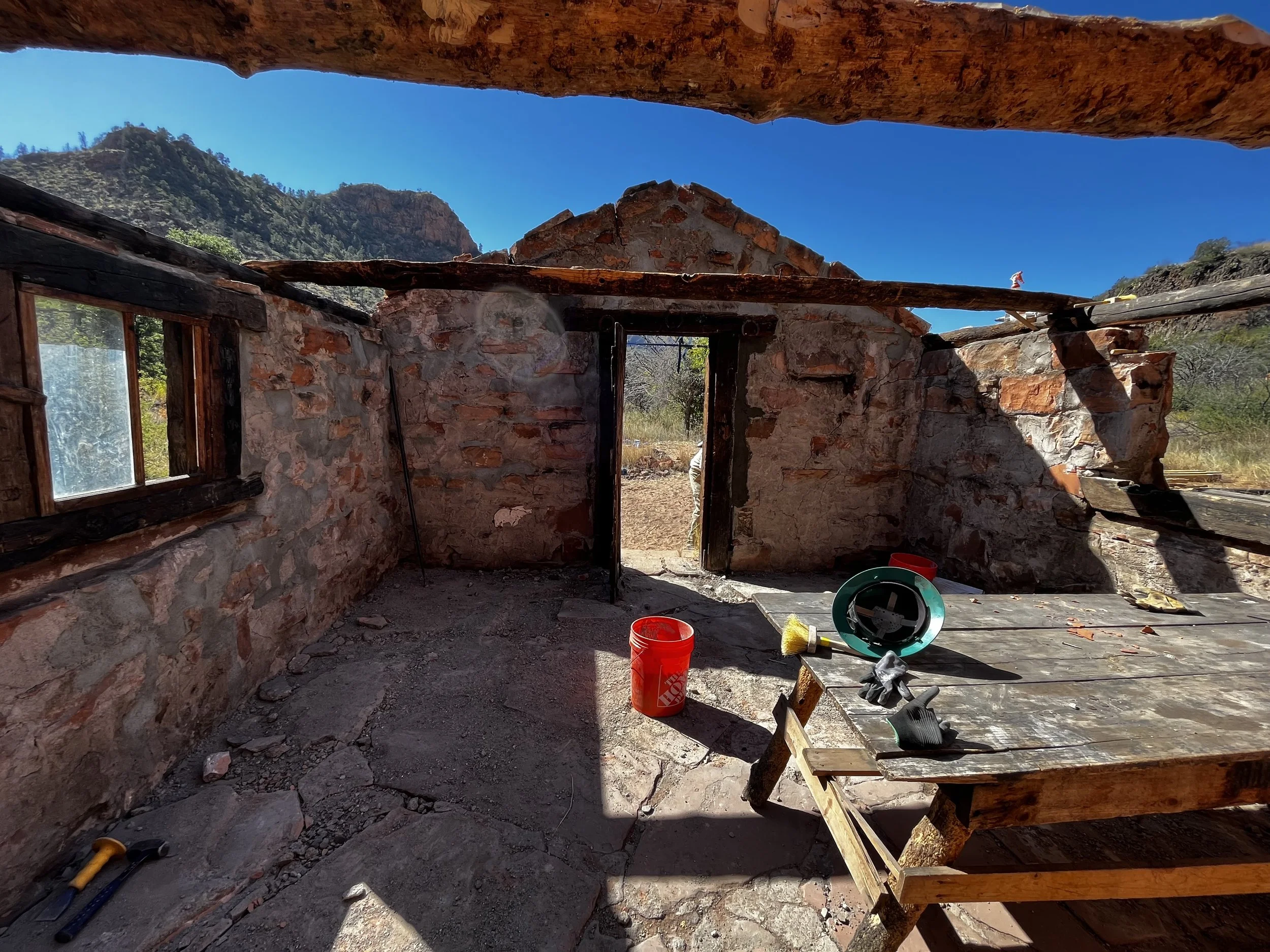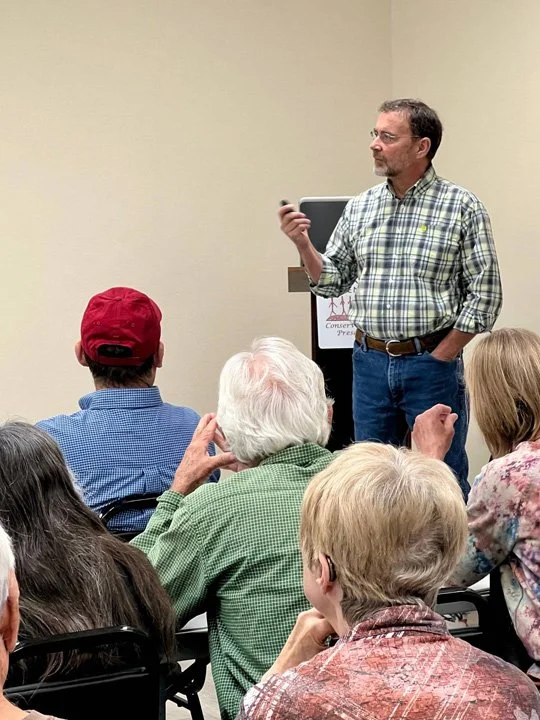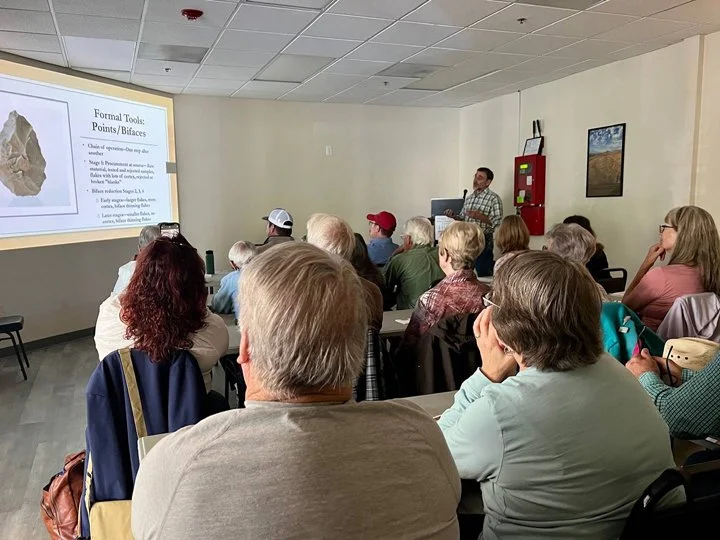Meet VVAC's Archaeologist John Rose
In February 2024, the Verde Valley Archaeology Center and Museum welcomed John Rose, PhD, RPA, as VVAC’s Archaeologist following his retirement from Prescott National Forest (PNF). Rose has had an extensive career working as an aircraft mechanic in the U.S. Air Force, conducting research in the jungles of Belize, and working as an archaeologist for various federal agencies in Idaho and Arizona. Rose didn’t stay retired for long after leaving PNF, starting his own archaeological services firm and providing his skills and expertise to VVAC.
Originally from Wisconsin, Rose grew up on Washington Island in Lake Michigan where his high school’s graduating class had seven people in it, joking that he was in the top ten of his class.
Unsure of what he wanted to pursue as a career, Rose joined the U.S. Air Force and was stationed at Williams Air Force Base in Mesa, Arizona, where he was an aircraft mechanic. When he was deciding what to do before leaving the service, he noticed that archaeology jobs for the federal government kept coming up.
“I saw that, and I thought, I never knew you could get a job doing that,” said Rose. “It sounds interesting, and I always wanted to get a career where I could use my head and also use my hands.”
He signed up for a field course at Pima Community College (PCC) in Tucson to see what a career in archaeology might look like, and found that it had everything that he was looking for: working outdoors, and using both tools and mathematical knowledge. To this day, Rose said that PCC has an excellent archaeology field program and is one of the few institutions with a field school.
Rose then went to the University of Arizona where he received his Bachelor’s Degree in Anthropology. It was here that he met graduate students doing work in Belize, and joined them for a few seasons doing archaeological mapping, skills he learned at PCC. Rose later received his Master’s Degree in Anthropology from the University of Pittsburgh, before returning to Belize for his dissertation research.
Rose’s dissertation focused on population growth of the Classic Period Maya at a site called La Milpa, working under Archaeologist, Norman Hammond. Rose recounted how fascinating it was to survey the areas selected by random under the canopy, with a crew of local Belizeans who chopped lines through the uncleared jungle. Rose and team would map the ruins that they found, which were mainly house mounds. This kind of work is now done primarily with LiDAR.
“It was a blast because you're on the ground running into all sorts of cool stuff,” said Rose about his time in Belize. He saw V shaped scars in trees cut by Westerners who cultivated chicle, as well as an array of wildlife, including howler monkeys, tropical birds, and venomous fer-de-lances.
He had traveled to Belize a number of times, but is especially fond of a visit he took with his wife and young daughter.
“Traveling with a young child like that, it really opened the community quite a bit,” said Rose. “Everybody can relate to kids.”
The most interesting thing Rose has found throughout his archaeology career was from one of these excavations in Belize, a small ceramic bird whistle. It had three holes, one in the beak, throat and tail, and by covering one or both holes, one could play different notes.
“It was so cool hearing the sound that people heard 500 years ago or more,” said Rose. “It was the coolest thing I ever found.”
Rose got his first full-time job with the government working as an archaeologist for the Bureau of Land Management in Kingman, Arizona. It was here that Rose started doing a lot of work with volunteer groups, like the Arizona Site Stewards, and first worked with Native American Tribes.
“Working with Native people gave me a whole new perspective on the importance of archaeology,” said Rose. “I first went into archaeology thinking that the importance was the data and the fact that you could reconstruct the past through the archeological data. Working with Tribes, I found out that a stronger value is on the human relationship to the sites and to the landscape these communities have.”
Rose then moved to Idaho, looking for a small town to raise his children in. He worked with the volunteer group Treasure Valley Backcountry Horsemen in the Frank Church-River of No Return Wilderness Area on projects like stabilizing old fire lookouts and log cabins. In a wilderness area, no motorized vehicles or tools are allowed, so Rose packed everything in on horses and mules and used traditional tools.
“It's so remote that to get to the trailhead, you're already in the middle of nowhere, and then from there, you go out with horses and mules for another 30 miles,” said Rose. “You're absolutely out in the middle of nowhere. It's wonderful.”
“That's kind of what drew me to it in the beginning,” continued Rose. “I never imagined that I'd be working out in the Frank Church-River of No Return Wilderness and in such remote settings, packing in on horses and mules, and restoring old log cabins. I never thought that was part of archaeology, but it is. For federal archaeologists, especially Forest Service archaeologists and Park Service archaeologists, that kind of work with old buildings is part of what an archaeologist does.”
While working at the Kingman field office, Rose helped start an archaeological training program for Tribal members from the Shoshone-Bannock Tribe. They found people in their late teens to early 20s who wanted to work for the Forest Service for a summer learning the basics of archaeology and archaeological surveying.
“When I first went into archaeology, I was told you'll never get a job doing that, and I never had a problem finding a job doing it,” explained Rose. “The federal careers are wonderful, and if you can find a national forest or a BLM office or a park that has a big wilderness to work in, that's the one to go for.”
Rose later became the Forest Archaeologist for Prescott National Forest (PNF) and served in this capacity for five years before retiring. Out of all the places he’s worked, PNF has been his favorite, mainly due to the good leadership and strong support throughout the community.
The proudest moment of his career was hiring five excellent archaeologists, and promoting a sixth, creating one of the strongest groups of archaeologists Rose has seen in any forest.
“Archaeology is great for the capability to reconstruct the past, but what it all boils down to is people, and the importance of people tied to the past and landscapes” said Rose. “For me, that’s the important part. In the end, it’s a cliché, but it's all about people.”
When Rose retired, he had no anticipated plans, but quickly remembered how he used to have a difficult time making it through a long weekend. He started Rio Verde Archaeological Services, LLC, where he does archaeological surveys, site recordings, and helps with ARPA damage assessments.
“When I received word that John Rose was going to retire from the Forest Service, I immediately put in a call to his office,” said Monica Buckle, VVAC’s Executive Director. “Who better to have than John Rose, who oversaw the archaeology of approximately 1.25 million acres. That's quite a feat and beyond impressive, so we were all thrilled when John agreed to onboard as our Archaeologist. VVAC has a robust archaeological team, and it's exciting to work with esteemed professionals, that with their talents will help to usher in VVAC's next phase of expansion, not only with the museum, but with the Cultural Resource Management (CRM) work we're conducting with emphasis to the Verde Region of archaeology. It's terrific to see the growth.”
“VVAC is blessed to have a superb relationship with Prescott National Forest throughout the years, in specific, our Cultural Resource Management work, as well as the survey work our talented volunteers conduct on Forest Service land for PNF,” continued Buckle. “Every month, Prescott National Forest hosts a luncheon for professionals in the archaeology field, which is testament to the holistic leadership of PNF's incredible staff. Several years ago, John Rose, had asked me, if VVAC would like to host a PNF luncheon? It further cemented the relationship with PNF and VVAC, and has now become an annual archaeologist luncheon VVAC hosts here at the museum.”
“As Director of VVAC, it's inspiring to work with colleagues that possess such breadth of knowledge,” added Buckle. “John Rose is a leader in this industry yet he is so personable, and generous with sharing his expertise with others.”







